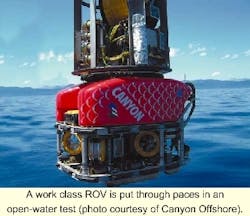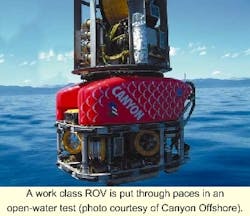SUBSEA PRODUCTION TECHNOLOGY - Work ROV contractors trying to evade cycle of more power, heavier umbilicals with depths
A remote operated vehicle (ROV) is essentially an underwater robot that allows the vehicle's operator to remain in a secure environment while the ROV works in the hazardous environment below. That is the key advantage to using the ROV over a diver in the limited depth regions that divers are able to work. Moreover, it is the only choice in the great depths that the offshore industry is routinely working in today.
The complete ROV system generally consists of the vehicle, which is connected to the control van and the operators on the surface support vessel or platform by an umbilical cable, a handling system to control the cable dynamics, a launch system, and associated power supplies. ROVs can vary in size from small vehicles with video cameras for simple observation up to complex work systems, which can have several dexterous manipulators, video cameras, tools and other equipment.
The umbilical carries the power and the command and control signals to the vehicle and the status and sensory data back to the operator stationed topside. In most cases, the umbilical includes additional strength members to allow recovery of heavy devices or wreckage.
For this survey, the term work class ROV refers to vehicles defined by Douglas-Westwood (The World ROV Report) as medium and large work class vehicles. These are the workhorses of the offshore service and heavy-duty work industry. They weigh 500-5,000 kg and generally have power ratings of 75-200 hp.
To allow for specific survey, payload, ease of maintenance, and work tool packages, they generally have an open frame construction. Standard equipment typically includes comprehensive control and instrumentation systems and multiple camera systems using fiber-optic data transmission. Commonly, a work class ROV is equipped with two heavy-duty dexterous manipulator systems. Older vehicles were often constructed for a special function, while more modern work class ROVs tend to be designed to be modular to accommodate a variety of tasks.
While the first ROVs of the early 1950s were nothing more than simple mobile camera platforms, with perhaps a clam shell claw, today's industry standard work class vehicle, with its complex tooling packages, can be designed to accomplish almost any task that can be performed at the ocean's surface. ROVs have progressed from this modest beginning as unpredictable prototypes developed mainly for research and military salvage into essential everyday tools without which many ocean industries, such as deepwater oil and gas production, would not be possible.
Work class ROV fleet
Research completed for this study shows that during the year 2000, at least 476 work class ROVs were in operation on behalf of 45 operating companies. The number of work class ROVs operating at the beginning of 1999 was estimated to be around 440. Nevertheless, this gain of roughly 36 units is a recognized under-estimate, with some ROVs being built as replacements for retired ones and several ROVs being sold to companies that operate them for "in house use only."
Of the 2,241 ROVs for which data were collected, the vast majority are observation vehicles (61%). Light work vehicles accounted for 14%, while the rapidly growing cable and burial maintenance sector represented 4%. Many operating companies are concentrating on the cable burial and pipeline trenching niche as the demand for more and more underwater fiber-optic cable communication systems continues to grow. Those vehicles classified as work class ROVs (21%), had an average maximum horsepower rating of 102 hp, an average payload capacity of 190 kg, and an average weight of 2,264 kg.
An important factor in the growth of the subsea business has been the boom in deepwater activity. The work class ROVs that operate in these areas have an average maximum operating depth rating of 2,129 meters. Several of the major work class ROV operating companies have performed systems checks at or near their ROVs depth ratings (2,000-6,000 meters). Although it may be difficult to qualify these tests as doing work, it is clear from the missions completed that the technology to go deeper exists.
Due to the enormous investments in money and time necessary to acquire the technical knowledge and experience sufficient to compete in the highly competitive market of ROV builder and operator, with new systems costing in the range of $0.4-4.0 million, major operators are few. The seven largest ROV operating companies account for 81% of the world's commercial work class fleet with most marine service companies designing and building their own ROVs.
Scientific work ROVs
The majority (97%) of work class ROVs in use are deployed in the offshore oil and gas industry. However, work class ROVs are becoming more common and heavily relied upon for scientific applications, represented by the recent addition of the work class ROV Hyper-Dolphin for Japan Marine Science & Technology Center (Jamstec) and the planned development of Jason II at Woods Hole Oceanographic Institution (WHOI). The Institute of Marine Biology at Crete uses its Max Rover MK II in conducting studies of hydrothermal vents. Monterey Bay Aquarium Research Institute uses the Tiburon and its modular mission-specific toolsleds to perform benthic, nektonic, and geological missions. Harbor Branch Oceanographic Institute has been heavily involved in the development of special work packages for marine scientific research vessels.
Using expertise developed in exploration of the Titanic in 1986, WHOI has continued a wide range of oceanographic studies. Under the direction of Dr. Robert Ballard, WHOI's work class ROV Jason was recently used in the discovery of the oldest sunken vessels known to man. The Phoenician ships yielded several ancient containers from a depth of over 750 meters. Jamstec continues the deep ocean research that brought its Kaiko to the ultimate dive in March 1995 where it reached the deepest point (10,911 meters) of the Marianas Trench.
Underwater intervention
While ROVs are increasing their importance to deep ocean studies, they are already involved with every aspect of offshore oil and gas production system installation. Before installation, ROVs are generally the tool of choice for site and route surveys. Once a detailed search and survey of the area has been performed, route surveys from the shore to the platform are conducted to select the best installation routes for pipelines and cables. The vehicles use very accurate acoustic tracking systems that work within long baseline acoustic networks so that the ROV position is accurately known.
The "work" in work class ROV comes from the primary use of the ROV in the offshore drilling support area. While observation ROVs are normally used as a visual aid in shallow water and where surface trees and jackup rigs are utilized, work class ROV systems are used in deeper water, areas of high current (2 to 3 knots), and when intervention tasks require the use of manipulators, fluid transfer, or payload bearing capabilities.
The inherent danger of this operation, no matter what the water depth, makes this an ideal task for the work class ROV. As working water depths continue to increase towards 3,000 meters, the role of the ROV will increase accordingly. Drill support duties require that ROVs have multiple dexterous manipulators, one as a grabber and the other as an extension of the operator at the surface, for performing complex tasks. Additionally, these vehicles often must deal with operation in high currents (2 to 3 knots) and may have to support large payloads (up to 800 kg for Stolt Offshore's Toolpusher).
Construction support requires the same manipulator dexterity as drilling support along with structural repair and installation tasks such as cutting and cable attachment. In addition to providing construction and drilling support, ROVs commonly perform other important tasks at the drill site, such as debris removal, recovery of cables, and the installation, laying, hookup, and commissioning of flowlines, trunklines, export lines, cables, and umbilicals.
Once an offshore oil and gas production system installation has been built, the work class ROV is the most common intervention tool for call-out work. Most work class operators have the capability to mobilize quickly and be ready to work once on site. Generally, these call-outs last for a few days although they may be extended to several weeks. Once the work is completed, the system is usually demobilized immediately.
Work class ROVs engaged in drilling or construction support are typically configured with a tether management system (top hat or cage), color zoom or low light video cameras, scanning sonar, low pressure water cleaning systems, or a brush for cleaning seals and bulls eye connections. Standard equipment includes an altimeter and depth transducer, high-powered lighting systems, and dexterous manipulators.
These manipulators are generally arranged in combination: five-function or heavy duty seven-function rate manipulator for moving payloads, manipulating the drill string, and for holding the ROV to a stable platform; while another seven-function spatially correspondent manipulator is used for fine manipulative tasks, hot stab deployment, and varying camera angles using a manipulator mounted camera. Other important tooling packages may include variable torque tools for activating valves and releasing hardware and locking mechanisms, while more specialized systems may have ring tools for replacing seal mechanisms and even guillotine pipe and cable cutters.
In every aspect of subsea hydrocarbon extraction, from jackup rigs in very shallow water to subsea completion, tension leg platforms and spars in deepwater, ROV technologies support activities. Requirements for ultra-deepwater (>1,500 meters) oil and gas production systems dominate the growth of the subsea market and because of the requirement for extensive intervention from work class ROVs. These same requirements correspondingly dictate much of the innovation of work class ROVs. When this is taken into account, along with the growing number of deepwater rigs, it is clear that the production from the deepwater and ultra-deepwater markets will fuel the research and development budgets of most ROV builders and operators in the near future. As of November 1999, the 34 deepwater rigs (305-1,789 meters water depth capability) in the Gulf of Mexico surpass the production of the other 713 shallower production units (Minerals Management Service).
Technology trends
There have been few major advances in ROV design in recent years. Most changes are the result of continuing evolution and the application of external technical developments in computing and electronics. A significant advance occurred when Alstom Schilling Robotics unveiled the Quest work class ROV at Underwater Interven-tion 2000. The need to design a smaller, simpler, more cost-effective package, with a marked increase in performance was the guiding force behind the development. With a research and development budget in excess of $15 million, Alstom Schilling (supported by Canyon Offshore) sought to accomplish a major new ROV development.
Graham Openshaw of Canyon Offshore noted the conundrum in most work class ROV development: "The perceived need for more horsepower has driven heavier power components. These require significantly more buoyancy, particularly in deepwater, increasing size and therefore drag, and needing yet more power with no net gain."
Only a substantial improvement in efficiency could break this cycle. This has been achieved using a unique 600 Hz power delivery system to reduce component size and increase efficiency and an innovative electric ring thruster with a single moving part. These improvements resulted in a measured vehicle performance of 4.2 kts forward/aft and 3.5 kts lateral during open water tests, equating to a handling capability not currently available in work class ROVs. Over the past two years, Alstom and Canyon have put every phase of their ROV system through rigorous testing, with final trials in 3,000 meters water depth scheduled before final delivery.
Modern work class ROVs must be extremely versatile systems. Specifically, they must be capable of being configured for many tasks at the same dive location and often on the same dive. These vehicles must also perform complex operations offshore in ever increasing water depths. Since the goal of the ROV is to accomplish an often complicated task, its overall capacity is restricted by two major factors - work requirements and required operational water depth. Both of these design considerations have fueled not only the design of the ROV, but also the makeup of the entire industry.
Industry trends
The acquisition of Global Industries' ROV assets by Oceaneering International Inc., the transformation of Slingsby Engineering Ltd and Perry Tritech into Perry Slingsby Systems Inc. along with the merging of French company ETPM S.A. with Stolt Comex Seaway to the subsequent re-naming of the company as Stolt Offshore mirrors the current fusing of large companies in other industries.
This growth in stature of the three largest operators, and correspondingly, three of the five largest manufacturers of work class ROVs signifies an important trend in the industry: the larger firms are amalgamating to substantially improve their already strong position in the deepwater markets. Even the builders of observation and light work class vehicles are merging forces, as in the case of Hydrovision Ltd. and Seaeye Marine. The goal in each merger is to be able to provide a larger range of services and to improve market share in the fastest growing regions while improving, if possible, the operator's strategic interdependence with the fluctuations of the oil and gas market.
Functionality trends
Three main areas are expected to dominate future ROV design and operation:
- Performing reliable operations in deepwater
- Improving power delivery and efficiency
- Increasing benefits to costs.
In the Gulf of Mexico, 96% of active oil and gas production units are installed in the shallower waters of the continental shelf. However, when considering wells that are under development and their production possibilities, the trend toward deepwater operations can be clearly seen. Correspondingly, the likely major offshore oil discoveries in future years will be in deepwater. As more and more companies commit themselves to deepwater projects, drawn in by high productivity of the major fields, work class ROV systems will be relied upon to provide the connection and service to these sites.
In order to provide the services the industry requires, at the depths it wishes, there must be dramatic changes in the work class ROV. The scientific community's work class ROVs exemplify this difficult situation. While their average maximum operating depth (3,890 meters) is 83% greater than the average work class, their average maximum horsepower (40 hp) rating is 155% lower.
As water depth increases, the burden of heavy, inefficient power delivery systems, exacerbated by dragging a longer heavier umbilical, requires the reduction in power in order to decrease weight and drag. There is also the cost incurred from the large deck equipment required to handle the large umbilical. For the offshore oil and gas production industry, going deeper means taking on increased costs. One solution to this problem is designing lighter, simpler, and more cost-effective ROVs, such as the powerful electric Quest and Oceaneering's E Magnum. The reduction or removal of hydraulic systems for propulsion and manipulation will greatly increase vehicle power conversion efficiency. In contrast, Oceaneering's dual system where one cage is used to transport both an observation ROV (Hydra Minimum) and work class ROV (Hydra Millennium), the requirements on umbilicals, deployment systems, and costs are reduced.
Another possible answer to providing more horsepower at greater water depths is to unleash the ROV. Some in the subsea industry speculate that going to autonomous underwater vehicles (AUV), which are tetherless programmed vehicles, will allow the subsea industry to advance past the technology plateau of extending the limits of cable controlled ROV operations.
Others make the case for a combination of both, that is a hybrid AUV-ROV, or ARV system. Like all hybrids, the main advantage of the ARV, is gaining the best traits of both systems. One proposed scenario has the AUV acting like a delivery vehicle. The ROV piggybacks on the AUV to the work site. Once at the site, the AUV unloads and connects the ROV to a subsea power source. Then the AUV is free to perform inspection tasks or recharge, and the ROV can complete its work class duties. AUVs have already proven themselves reliable for short missions where their limited power supplies and their operators' fears of losing a long ranging unconnected vehicle are not stretched too far. Over time, improvements in fuel cell technology may make AUVs an even more attractive option.
Addressing the problems in such a system is daunting, but the prospect of developing a system for very deep water where an ARV, specifically designed for such depths and inspection duties, is deployed from a floating production, storage and offloading (FPSO) facility is equally intriguing. The ARV would need the ability to dock onto local subsea power and communications ports, and therefore be connected to some form of subsea power and data interface where it would be free to conduct work and inspection tasks. This would be at a considerable distance from the point of deployment and beyond the conceivable range of a conventionally rigged ROV.
One firm, Cybernetix S.A., has undertaken a project entitled "subsea work inspection and maintenance with minimum environment ROV" (Swimmer), where they have designed a prototype system with a work class ROV. Cybernetix's ultimate goal is to work with oil and gas companies to obtain access to a production field and build an industrial model capable of interventions in 3,000 meters water depth. As the ROV industry continues to progress, the major manufacturing and operating companies have made a commitment to produce more user-friendly and easier to maintain work class ROVs capable of providing more horsepower at greater water depths.
Authors
Robert J. Wagner is a MS degree candidate in the Ocean Engineer Program in the Civil Engineering Department of Texas A&M University.
Robert E. Randall, Ph.D., P.E. is a Professor in the Ocean Engineering Program in the Civil Engineering Department of Texas A&M University.
E. Kurt Albaugh, P.E. is an Engineering Consultant with Mustang Engineering and Technical Advisor/Poster Editor for Offshore Magazine.
References:
Liddle D, Rousing D & Westwood J, 2000. The World ROV Report. Douglas-Westwood Ltd. www.dw-1.com
Marine Technology Society ROV Committee, 1998. Operational Effectiveness of Unmanned Underwater Systems. Marine Technology Society. CD-ROM.
United States Department of Interior Minerals Management Service, July 2000. Deepwater Gulf of Mexico: America's Emerging Frontier. (OCS Report MMS 2000-002), www.gomr.mms.gov/homepg/whatsnew/techann/000022.html




